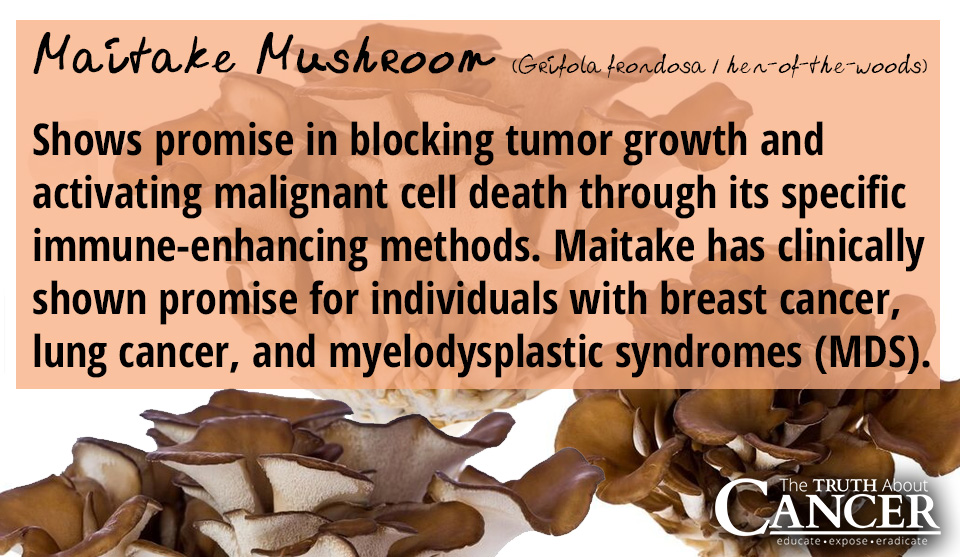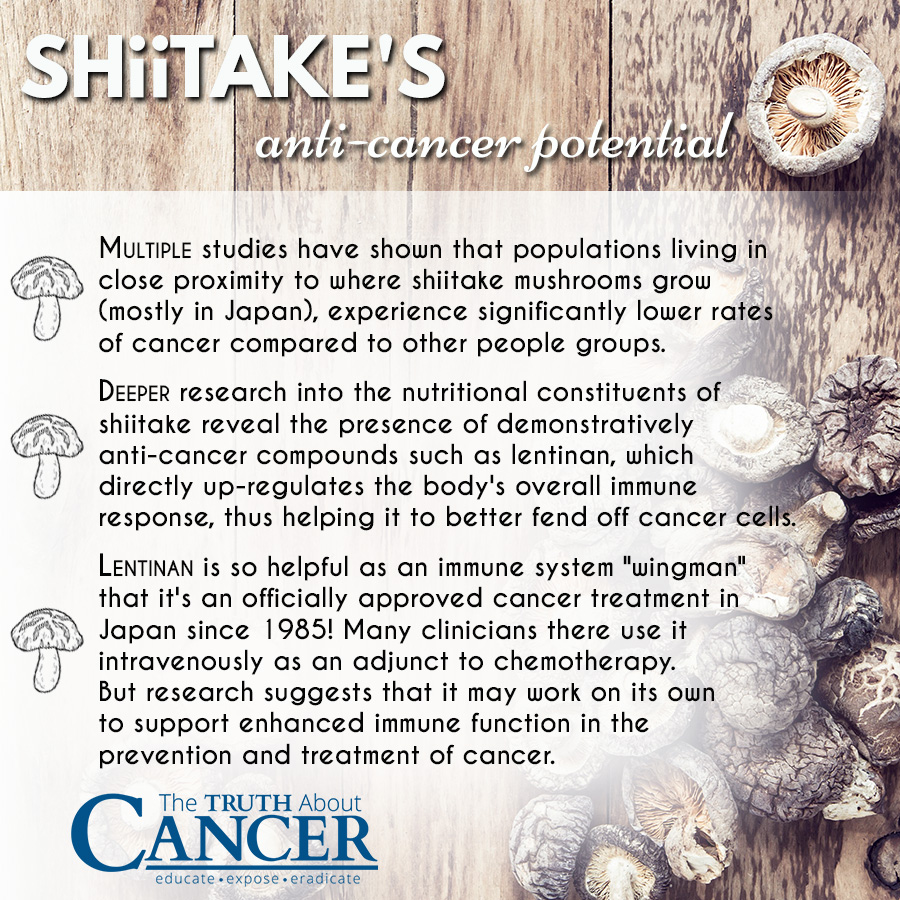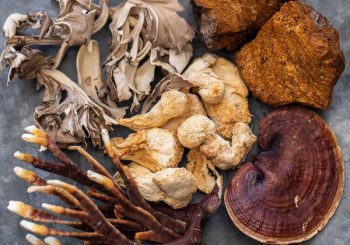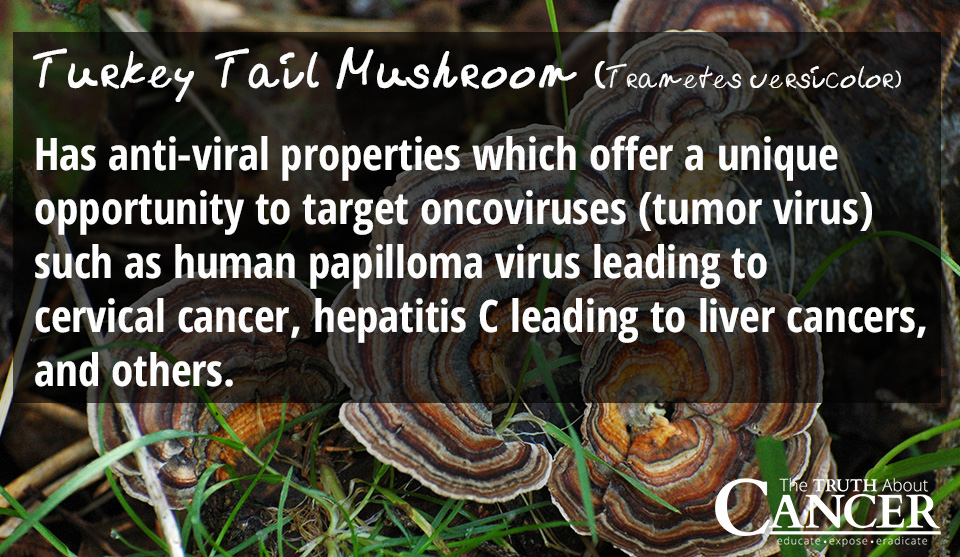By Ty Bollinger
Guest Writer for Wake Up World
Having secured a rich history in many ancient Asian healing practices, medicinal mushrooms have been prescribed and used for countless ailments for thousands of years. As modern medicine rediscovers these ancient superfoods, there is good evidence that mushrooms are among the most powerful functional foods in a growing cancer-fighting and cancer-prevention arsenal.
[pro_ad_display_adzone id=”110028″]
Modern research confirms what many traditional healers have known for centuries – that mushrooms contain some of the most potent, yet safest medicinal ingredients found in nature. What’s more, most of these ingredients cause very few side effects – if at all – even at very high doses.
It is first important to differentiate between the anti-cancer medicinal mushrooms and the countless other common varieties. A quick visit to the local supermarket will reveal culinary mushrooms such as oyster, portabella, and others. Although these have their health benefits, the focus of this article will be on four of the more specialized and not typically commercially grown reishi, maitake, agaricus blazei murill, and turkey tail mushrooms.
It’s clear now that mushrooms are legitimate treatments in their own right for many health conditions, including diabetes, Alzheimer’s disease, and cancer.
Medicinal Mushrooms and Cancer
There are a few primary mechanisms that most of these functional, anti-cancer mushrooms share when assisting the body during cancer stages or in simple everyday prevention. First is their ability to enhance the body’s first line of defense against cancer – the immune system. When this system is weak or has failed, the mechanism for cancer has a better opportunity to manifest.
Next, some anti-cancer mushrooms exhibit direct antiviral and tumor shrinking abilities. As mentioned above, side effects are rare and mild but it is still important to talk with your healthcare provider before use.
It has been demonstrated that, in some cases, formulas containing multiple strains of different mushroom extracts often exhibit synergistic, complementary, and amplified effects. This is in stark contrast to many of the negative cumulative effects of chemotherapy drugs and radiation therapy methods commonly prescribed in hospitals today. As with research for many alternative treatments, the United States has been late to the party when it comes to medical research on the anti-cancer and overall health benefits of mushrooms.
#1. Reishi Mushroom Benefits: The Mushroom of Immortality
Used for over 2000 years by sages and shamans and known in China as the “spirit plant” – also known as Mannentake, Ling Zhi or Ling Chi – Reishi relaxes and fortifies both mind and body. This fungus holds a very important place in the traditional medical systems of China, Japan, and Korea.
Ganoderma lucidum, or better known by its common name, reishi, it is one of the most well-known medicinal mushroom in Asian healing arts. The mushroom’s bioactive molecules and polysaccharides have been shown to better activate natural killer (NK) cells reducing cancer metastasis. NK cells are lymphocytes that perform immunosurveillance within the body, constantly on the lookout for “immuno-alerters” signaling tumor presence.
Reishi also has been shown to assist in slowing the growth (angiogenesis) of tumors as well as triggering programmed cell death in malignant cells. Currently, there is data to support the potential use of reishi as, at the very least, an adjunct therapy for colorectal cancer, lung cancer, prostate cancer, and breast cancer.
Studies have shown that Reishi helps to:
- Counter free radicals and fight inflammation. Reishi has potent antioxidant and anti-inflammatory properties. In fact, Reishi compares very favorably to the synthetic anti-inflammatory drug prednisone, without the side effects. Also, Reishi may be able to counter our susceptibility to many aging-associated diseases, thanks to its powerful ability to fight free radicals and reduce cellular damage associated with oxidative stress.
- Enhance immune system activity. Reishi enhances multiple aspects of the immune system in advanced stage cancer patients and lung cancer patients.
- Fight cancer. Reishi ingredients are toxic to multiple cancer cell lines in culture – including leukemia, breast, ovarian, cervical, and lung cancer cells, among others. Evidence suggests Ganoderic acid is a potential anti-metastatic agent. Metastasis is the migration of cancer cells from their place of origin to other areas of the body.
#2. Maitake Mushroom Benefits: The Dancing Mushroom
Maitake, like the reishi mushroom, also contains a broad-spectrum array of bioactive molecules. In studies, maitake has shown similar results as the reishi mushroom in stimulating NK cell activity in cancer patients. The mushroom also shows promise in blocking tumor growth and activating malignant cell death through its specific immune-enhancing methods. Maitake has clinically shown promise for individuals with breast cancer, lung cancer, and myelodysplastic syndromes (MDS).
#3. Agaricus Blazei Murill: Tokyo’s Cancer Secret
This mushroom made perhaps the biggest splash when a study jointly conducted by the Medical Department of Tokyo University, The National Cancer Center Laboratory, and Tokyo College of Pharmacy showed a complete recovery in 90% of guinea pigs injected with cancer cells (180 sarcoma).
The pattern of other mushrooms was seen again as agaricus blazei murill activated macrophage and interferon immune activity leading to tumor shrinkage, a halt in metastasis, and reduction of future cancer occurrences. As an adjunct, agaricus blazei murill was shown to lessen the side effects in individuals undergoing chemotherapy for endometrial, cervical, and ovarian cancers.
#4. Turkey Tail: The Natural Japanese Cancer Drug
In 1976, a Japanese company patented certain extracts of this mushroom under the name PSK and later PSP. They have since become recognized cancer drugs in Japan. The anti-viral properties of the turkey tail mushroom offer a unique opportunity to target oncoviruses (tumor virus) such as hepatitis C leading to liver cancers, and others. For this mushroom, again studies are showing increased NK activity towards tumor detection and eradication.
It is important to note that drug companies cannot patent mushrooms. Due to this fact, funds typically won’t be allocated to study them unless they come from private institutions or government grants. However, this should be a positive as many studies only seek to isolate one part of a plant or mushroom to patent as a drug.
As mycologist (mushroom expert) Paul Stamets states,
Isolating one constituent from the others denatures and lessens the broad-spectrum potency of this natural, functional food.”
#5. Cordyceps: The Caterpillar Fungus
Cordyceps (Cordyceps sinensis) is also known as the Caterpillar Fungus and Dong Ching Xia Cao (Summer grass, winter worm), Cordyceps has long been a part of traditional Chinese and Tibetan medicine. An extremely rare combination of a mummified caterpillar and a fungus, it is found at very high altitudes in the Himalayas, on the Tibetan plateau, and other high-altitude locations around the world.
Cordyceps – both the mummified caterpillar and the fungus – contain many potent bioactive compounds, including cordyceptin, cordycepic acid, polysaccharides, and sterols.
Studies have shown that Cordyceps helps to:
- Manage blood sugar levels in a healthy range. Emerging evidence indicates that the Cordyceps is likely to prove to useful in the management of diabetes.
- Improve transplant success rates. Cordyceps protects the heart and lowered the rate of cardiac rejection in an animal model of heart transplantation. When given after kidney transplants, Cordyceps also reduced the rejection rate, improved kidney and liver function, boosted red blood cell production, and lowered infection rates in patients.
- Strengthen the immune system. Cordyceps boosted production and activity of various components of the immune system in animal experiments.
- Enhance antioxidant ability. Cordyceps raised levels and activity of innate enzymatic antioxidant systems in animal models.
- Boost libido. Cordyceps boosts libido and sexual activity, along with restoring impaired reproductive function in animals as well as humans.
- Improve exercise performance. Cordyceps made international headlines by helping Chinese runners break two world records by huge margins at the Asian Games in 1993. Cordyceps likely improves stamina because it stimulates production of ATP, one of the main sources of energy in our body’s cells. Cordyceps has also been shown to dilate the aorta – the main artery in the body that supplies oxygenated blood to the entire circulatory system – by 40%, greatly increasing blood flow and enhancing endurance.
- Fight cancer. In laboratory experiments, Cordyceps was selectively toxic for cancer cells, without affecting normal, healthy cells. Bioactive ingredients in Cordyceps including cordyceptin attack and destroy mouth, bladder, prostate, breast, liver, lung, cervical, leukemia, and colorectal cancers as well as lymphoma, melanoma, and neuroblastoma in culture.
#6. Chaga: “The Mushroom of Immortality”
Chaga mushrooms are fungi that grow on the bark of various trees, such as birch. These mushrooms thrive in moderate climates and are often found in countries like Russia, Canada, Siberia, the northeastern USA, and Korea. Long used in folk medicine, Chaga contains massive amounts of the pigment melanin, which causes the exterior of the mushroom to turn a deep black when exposed to the sun.
In test tube studies, chaga extract has been shown to suppress the progression of cancer, including liver, lung, colon, prostate, and breast. In a study published in the journal of Biomedicine & Pharmacotherapy, researchers observed that obese and diabetic mice treated with chaga extract exhibited reduced insulin resistance as well as lower blood sugar levels.
Chaga is known by many names around the world. Most interestingly, it is called ‘kreftkjuke’ in Norway, which literally translates to “cancer fungus” due to its purported health properties.
Learn more about chaga here.

#7. Shiitake: “Miracle Mushroom”
Also known as “dongu” in China, shiitake mushrooms can be found growing wild in the forests of several East Asian countries. The word “shiitake” is actually derived from the Japanese words “shii” (type of tree where these mushrooms grow) and “také” (meaning ‘mushroom’). In other words, the name literally means “mushrooms of the shii tree.”
Some of the medicinal properties of shiitake mushroom are attributed to a potent anti-fungal sugar molecule named “lentinan.” In laboratory tests, lentinan does not kill cancer cells directly, but enhances a number of aspects of the immune system, which may aid in the slowing of tumor growth.
One study published in the Journal of Alternative and Complementary Medicine showed that oral administration of lentinan helped slow the development of small tumors and also helped inhibit the proliferation of leukemia cells. Another study found that the aqueous extracts of shiitake mushrooms contain compounds that are antimicrobial, anti-inflammatory, protect the liver, and are also a potent antioxidant.
Famous for their meaty texture and earthy, smoky flavor, they’re the second most commonly cultivated edible mushrooms. However, when eaten raw, shiitake mushrooms can cause shiitake dermatitis, a skin eruption that resembles whiplash marks. If you’re planning to use shiitake mushrooms in your meals, be sure to cook them properly.
A final note on mushroom safety: there are many species of mushrooms that are highly poisonous to humans. It is strongly advised that individuals do not wild gather mushrooms for consumption unless you have done extensive research.
Sources and References:
- Paul Stamets, “MycoMedicinals: An Informational Treatise on Mushrooms”, (MycoMedia Productions), 2002.
- Ganoderma lucidum (Reishi) Inhibits Cancer Cell Growth and Expression of Key Molecules in Inflammatory Breast Cancer
- Paul Stamets, “MycoMedicinals: An Informational Treatise on Mushrooms”, (MycoMedia Productions), 2002), 24-29.
- Hokkaido Reishi
- Reishi Mushroom
- Studies on the immuno-modulating and anti-tumor activities of Ganoderma lucidum (Reishi) polysaccharides.
- Radical scavenger and antihepatotoxic activity of Ganoderma formosanum, Ganoderma lucidum and Ganoderma neo-japonicum.
- Polysaccharides in fungi. XIV. Anti-inflammatory effect of the polysaccharides from the fruit bodies of several fungi.
- Effects of ganopoly (a Ganoderma lucidum polysaccharide extract) on the immune functions in advanced-stage cancer patients.
- A phase I/II trial of a polysaccharide extract from Grifola frondosa (Maitake mushroom) in breast cancer patients: immunological effects.
- Protection against lung cancer patient plasma-induced lymphocyte suppression by Ganoderma lucidum polysaccharides.
- New triterpene aldehydes, lucialdehydes A-C, from Ganoderma lucidum and their cytotoxicity against murine and human tumor cells.
- Ganoderma lucidum exerts anti-tumor effects on ovarian cancer cells and enhances their sensitivity to cisplatin.
- A water-soluble extract from culture medium of Ganoderma lucidum mycelia suppresses the development of colorectal adenomas.
- Ganoderic acid Me inhibits tumor invasion through down-regulating matrix metalloproteinases 2/9 gene expression.
- The in vitro and in vivo experimental evidences disclose the chemopreventive effects of Ganoderma lucidum on cancer invasion and metastasis.
- Isolation of an antitumor compound from Agaricus blazei Murill and its mechanism of action
- Heavy Metals Accumulate More In Some Mushrooms Than In Others
- Fungi and ionizing radiation from radionuclides
- Paul Stamets, “MycoMedicinals: An Informational Treatise on Mushrooms”, (MycoMedia Productions), 2002), 57-62.
- Cordyceps
- Traditional uses and medicinal potential of Cordyceps sinensis of Sikkim
- Polysaccharides in fungi. XXXVI. Hypoglycemic activity of a polysaccharide (CS-F30) from the cultural mycelium of Cordyceps sinensis and its effect on glucose metabolism in mouse liver.
- CordyMax Cs-4 improves glucose metabolism and increases insulin sensitivity in normal rats.
- [Antiarrhythmic effects of Cordyceps sinensis (Berk.) Sacc].
- C. sinensis ablates allograft vasculopathy when used as an adjuvant therapy with cyclosporin A.
- [Clinical study on application of bailing capsule after renal transplantation].
- Cordyceps militaris polysaccharides can enhance the immunity and antioxidation activity in immunosuppressed mice.
- Cordyceps as an Herbal Drug.
- Are Cordyceps Magic, Medicinal Mushrooms?
- The scientific rediscovery of an ancient Chinese herbal medicine: Cordyceps sinensis: part I.
- The apoptotic effect of cordycepin on human OEC-M1 oral cancer cell line.
Originally published at The Truth About Cancer and reproduced here with permission.
About the author:
 Ty Bollinger is a health freedom advocate, cancer researcher, former competitive bodybuilder and author. After losing several family members to cancer, he refused to accept the notion that chemotherapy, radiation, and surgery were the most effective treatments available for cancer patients. He began a quest to learn all he possibly could about alternative cancer treatments and the medical industry. What he uncovered was shocking. There is ample evidence to support the allegation that the “war on cancer” is largely a fraud and that multinational pharmaceutical companies are “running the show.” Ty has now made it his life mission to share the most remarkable discovery he made on his quest: the vast majority of all diseases, including cancer, can be easily prevented and even cured without drugs or surgery.
Ty Bollinger is a health freedom advocate, cancer researcher, former competitive bodybuilder and author. After losing several family members to cancer, he refused to accept the notion that chemotherapy, radiation, and surgery were the most effective treatments available for cancer patients. He began a quest to learn all he possibly could about alternative cancer treatments and the medical industry. What he uncovered was shocking. There is ample evidence to support the allegation that the “war on cancer” is largely a fraud and that multinational pharmaceutical companies are “running the show.” Ty has now made it his life mission to share the most remarkable discovery he made on his quest: the vast majority of all diseases, including cancer, can be easily prevented and even cured without drugs or surgery.
For more information, visit:
[pro_ad_display_adzone id=”110027″]








